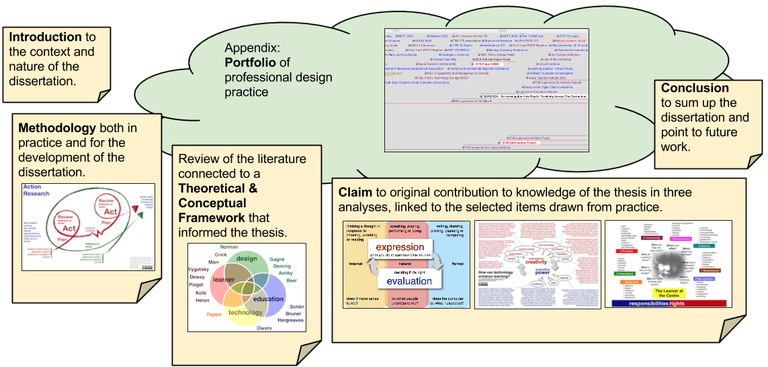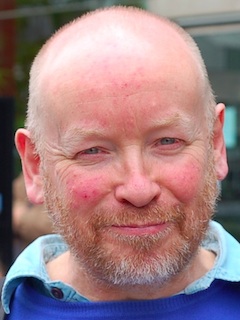Introduction
Aims
The Claim section sets out the three key analyses which are referenced in the form [Ax] and these are supported with reference to the individual, specific and more diverse aims of my selection from a portfolio of practice, together with a triangulated assessment of my contribution to each item and their originality, impact and importance and the evidence for that judgement. These items of practice are referenced in the text in the form [Px] and can be found with a full description in Appendix 1.
(Words: 142 )
Structure of this dissertation

Figure 1: The structure of the dissertation
(Words: 43 )
About Richard Millwood
In writing this dissertation, I came to realise that all the practice I had been engaged in had a common thread: an ambition to improve education through a better, theoretically-informed design practice for innovations using technology
I have been trying to do this since 1978 as a design practitioner in technology-enhanced learning. I have sought analytical and descriptive means to improve designs through effective design & development processes. I have focussed on learner-centred approaches and researched widely across multiple disciplines. My practice has also involved teaching at all levels, specifically at Masters level since 1984 and the supervision of PhD students since 1997.
I am currently a Director of Core Education UK Ltd, a non-profit organisation and I am Assistant Professor and Course Director for the MSc in Technology and Learning at Trinity College Dublin. Until July 2013 I was Reader in Distributed Learning in the Institute for Educational Cybernetics at the University of Bolton as well as a Research Fellow at Brunel University until September 2013. I am responsible for the National Archive of Educational Computing and contributor to the Work Focussed Learning project. I also maintain a blog, a New Learning Landscape, and occasionally tweet as @richardmillwood.
I am a Fellow of the Royal Society for the Encouragement of Arts, Manufactures and Commerce (FRSA) and of the British Computer Society (FBCS) and have been an Apple Distinguished Educator since 2000. I have recently served as a secondary school governor, having previously chaired a primary school governing body for six years. I am active in the Labour Party, currently serving as Chair of the Brentwood and Ongar Constituency Labour Party and I am a founding member of Educating Brentwood, a local group dedicated to improving educational accountability.
(Words: 356 )
PhD by practice
In my case, I am presenting my work as a designer of technology-enhanced, learner-centred education. In this dissertation, in the section titled 'Claim', I propose and offer evidence that some of this work has been state-of-the-art and has made substantial original contribution to the learning technology field.
I have straddled the groups of learning technologists and educational developers in my work, and these groups have only emerged in my lifetime, as reported in Alison Hudson's PhD Thesis 'New Professionals and New Technologies in New Higher Education?' (Hudson 2009).
Hudson's study suggests that:
…both groups occupy a highly politicised position, are affected by the shifting value of social, cultural and economic capital in the constantly changing higher education, are subject to struggle regarding ‘position’ and agency and are susceptible to the demands of new power regimes and technological solutions.
(Hudson 2009, Abstract)
My work has encompassed early years, school and informal lifelong learning, although throughout most of my career I have been employed in higher education research & development contexts, frequently in short term contracts and struggling to establish a 'position'.
This struggle with 'position' has made the PhD by practice suitable for my situation, since the combination of disciplines necessary to carry out my work has shifted from instructional design, to multimedia creativity, to course design and ultimately the design of systems of schooling and higher education. Thus I have never 'settled down' in any subject disciplinary sense, instead obtaining coherence from the focus on design, development, marketing, teaching and leadership in the creation of innovative 'products' at many levels. This combination of disciplines also leads me to draw broadly on theoretical and conceptual literature, and my literature review is spread throughout this thesis. Arguably I have experienced an ‘expansive education’, in response to Engstrom’s problem “the elusive and uncontrollable nature of expansive processes where human beings transcend the contexts given to them” (Engstrom 1987), in my case stimulated by new technology developments. Thus I have defined multiple aims in the process of developing this thesis since it is in the nature of expansive education that a single research question could not represent my original contribution.
The consequence of these matters, together with the shorter account (20,000 words), the absence of a standalone literature review chapter and the range of eclectic practice itself, makes this approach challenging as compared to those made in more traditional and focussed PhD forms. Winter et al, in their paper The 'Academic' Qualities of Practice: What are the criteria for a practice-based PhD?, address this question head on, and suggest (minimally) that:
…a PhD ought to:
- be a report of work which others would want to read;
- tell a compelling story articulately whilst pre-empting inevitable critiques;
- carry the reader into complex realms, and inform and educate him/her;
- be sufficiently speculative or original to command respectful peer attention.
A rigorous critical appraisal, normally between 10,000 and 15,000 words
(University of Bolton, 2008)
Table 1: Specific criteria for the PhD by Retrospective Practice at the University of Bolton and my response
| Criterion | Response |
|---|---|
|
1. details of specific dates and locations in relation to the conduct of the research on which the submission is based; |
To be found in the first Appendix - Portfolio |
|
2. an analysis of the general and specific aims of the research programme, including an analysis of its component parts and a synthesis of the works as a coherent study; |
To be found in the overall aim stated in the Introduction and in the aims for each item of practice in the Claim section. |
|
3. a discussion of the contribution made by the submitted works or evidenced by the items within the portfolio to the general advancement of the field of study and research area or professional or creative practice, which demonstrates a common theme; |
To be found in the summary of the Claim and the discussion of each item of practice in the Claim, where reflections on learning, contribution, originality, impact and importance are made and empirical support for the the three analyses which form the thesis. The Conclusion includes a summary of the contribution. |
|
4. a demonstration that the work or the practice constitutes an independent and original contribution to knowledge in the chosen field; |
To be found in the discussion of each selected item of practice in the Claim, where reflections on learning, contribution, originality, impact and importance are made. |
|
5. a review of the current literature, unless already incorporated within any of the other items submitted. |
To be found throughout in the Methodology, Theoretical & Conceptual Framework and Claim. |
(Words: 956 )


